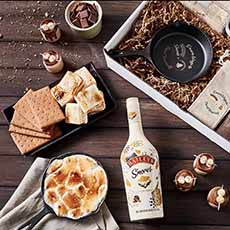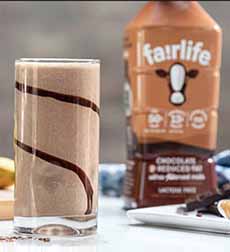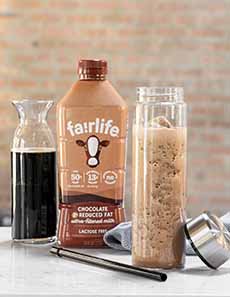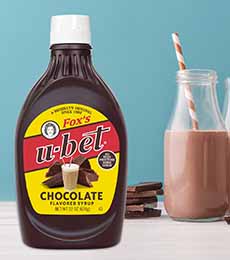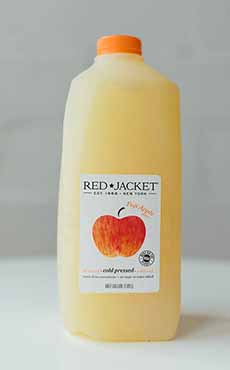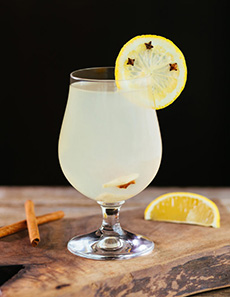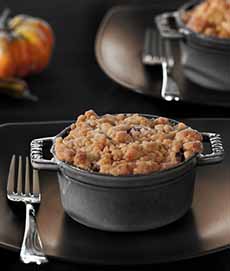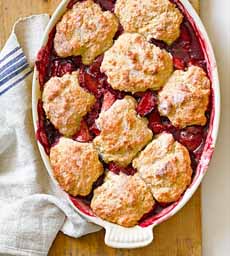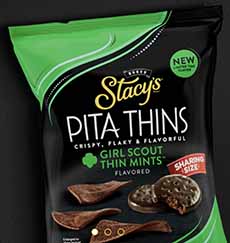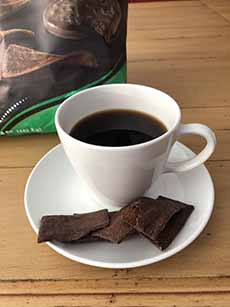|
It’s September 27th, National Chocolate Milk Day. You don’t have to be a kid to go for it.
You can pour a glass, of course. But here are six easy-to-make chocolate milk recipes from Fairlife, which makes lactose-free chocolate 2% ultra-filtered milk.
> The history of chocolate milk. Yes, someone actually invented it!
A recipe for homemade chocolate syrup.
> The history of chocolate syrup is below.
BREAKFAST
Whipped Mocha Cream: Top off your morning coffee with an easy chocolatey twist (photo #3). Check out this easy five-minute recipe.
Frozen Chocolate Cold Brew Smoothie: A quick and easy recipe gives you both a chocolate and coffee fix in no time (photo #2).
Chocolate Pancakes: Substitute the milk in your pancake recipe with chocolate milk. Fun!
AFTERNOON COOL-DOWN
Chocolate Peanut Butter Smoothie: There’s nothing like a tasty mid-day snack to get you to the end of the day. Check out this easy 2-minute recipe (photo #1).
Chocolate Milk Ice Pops: Freeze your favorite chocolate milk into an ice pop mold for the easiest Fudgesicle®-type treat. Enjoy one post-workout or hand them to the kiddos.
WARM-UP
Hot Chocolate Milk: Pop a mug of chocolate milk into the microwave for 2-1/2 minutes or so (start at 2 minutes to test your microwave). Drink plain, or top with whipped cream or marshmallows. For the holidays, add a mini candy cane (photo #4)
CHOCOLATE MILK NIGHTCAP
Boozy Chocolate Milk: For late-night sipping, add chocolate liqueur and chocolate vodka to a glass of chocolate milk. You’ve just made a Chocolate Milk Martini!
THE HISTORY OF CHOCOLATE SYRUP
There would be no chocolate milk if there were no chocolate syrup.
Chocolate syrup was first made by pharmacists for medicinal purposes, following the invention of cocoa powder in 1828.
That year, Dutch chemist Coenraad J. Van Houten patented a press that successfully removed some of chocolate’s natural fats, reducing its bitterness and turning it into a powder that could dissolve in water (the history of cocoa powder).
It’s unclear exactly when pharmacists first combined cocoa powder, sugar, and water to make chocolate syrup. But to make medicines palatable, pharmacists would mix the cocoa powder with at least eight times more sugar than cocoa [source].
In those days before the mechanized production of pills, medicinal syrups were more common. A base of sugary flavored syrup, like chocolate, would be combined with medicinal components.
The popularity of chocolate syrup exploded in the second half of the 19th century, for medicine as well as soda fountain drinks.
This coincided with the golden age of patent medicines, which at that time were over-the-counter drugs.
An advertisement for Hershey’s cocoa powder appeared in the December 1896 issue of the trade magazine, “The Druggists Circular and Chemical Gazette.” The ad touts Hershey’s “Soluble Chocolate” and in parentheses underneath, “Powdered Cocoa.”
You can see the ad here, right next to an ad for soda water making equpmnent for druggists.
At that time, many pharmacies had soda fountains. So the chocolate syrup had a double purpose: mixed with regular water for medicinal syrup, mixed with carbonated water for a chocolate soda drink.
It later became used for ice cream sodas, sundaes, and other soda fountain treats. To-be-famous brands of chocolate syrup emerged so that every home could have a bottle: Bosco, Fox’s U-bet (photo #7), and Hershey’s, among others. Today, better chocolatiers, such as Ghirardelli and Guittard, also make chocolate syrup (dark, milk, and white!).
We would be remiss if we didn’t tie in the story of chocolate syrup with carbonated water.
Carbonated Water
Before aspirin was invented in 1898, common digestive problems such as indigestion were alleviated with a glass of naturally effervescent volcanic spring water, which was rich with natural minerals.
People went to spas to drink it and brought some back with them.
This medical aspect drove experiments by professionals and amateurs alike to create carbonated water.
In 1767, the English chemist Joseph Priestley was the first to artificially carbonate water with carbon dioxide. He hung a vessel of water over a fermentation vat at a brewery. Fermentation vats naturally give off CO2 in the process of converting sugars into low alcohol.
Priestley didn’t try to commercialize his discovery but shared his process. His scientific paper caught the eye of a young watchmaker in Geneva, Johann Jacob Schweppe.
Schweppe saw a big commercial opportunity. He simplified the carbonation process through the application of two common chemicals, sodium bicarbonate (bicarbonate of soda) and tartaric acid.
He then left watchmaking behind and set up mass production of the Schweppes brand of carbonated water.
But the carbonated water, sold in bottles, had a salty taste imparted by the chemicals.
Sugar and flavorings were soon added to make the drink more palatable. Carbonated water began to be imbibed for not just medicinal reasons, but as a pleasurable beverage.
This was the beginning of bicarbonate of soda becoming soda water, then “soda pop” and later, simply “soda” [source].
The carbonated water came in bottles that weren’t as convenient as they could be. Around the turn of the century, pharmacist Jacob Baur of Terre Haute, Indiana, sought a better option.
He invented the process to create pressurized carbon dioxide, liquefying the gas so it could be distributed pressurized in cylinders. The cylinders went underneath the soda fountain’s prep area, connected to a nozzle that was pulled (or jerked) by the counter attendant (or soda jerk).
A company with investors was formed and in 1889 sales of cylinders of Red Diamond carbon dioxide gas commenced.
Once soda bottlers and soda fountain operators realized the convenience and safety of carbon dioxide cylinders, the demand grew quickly [source].
The chocolate syrup got mixed with carbonated water. The delicious treat was also a “health drink,” in the terms of the day. Today we recognize that cocoa powder may have great antioxidant properties, but not when it’s sweetened with an 8:1 ratio of sugar!
Bauer became known as “The Father of the Soda Fountain.”
|


